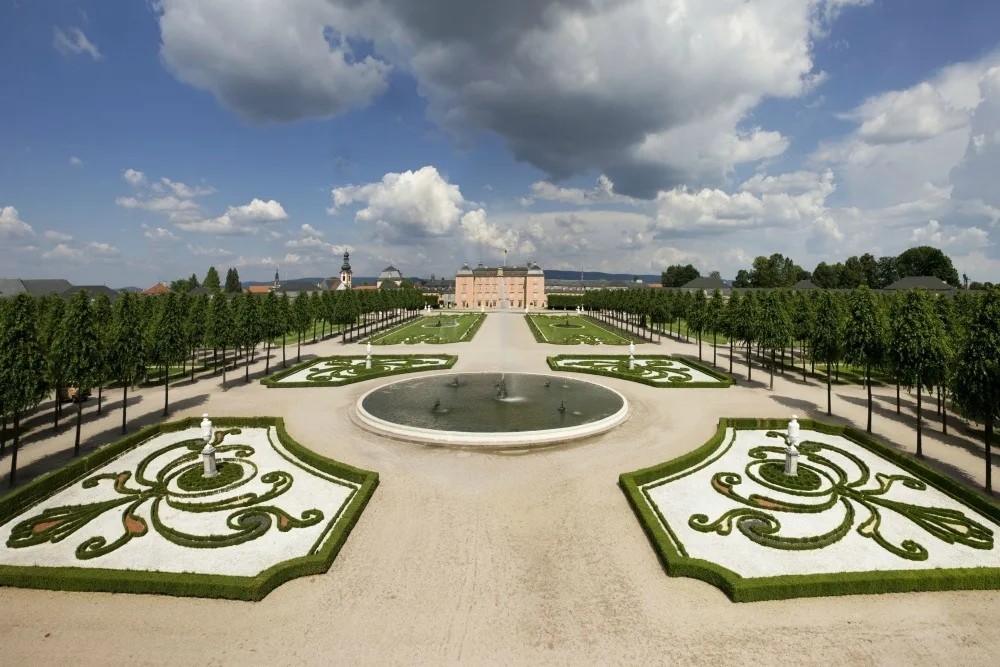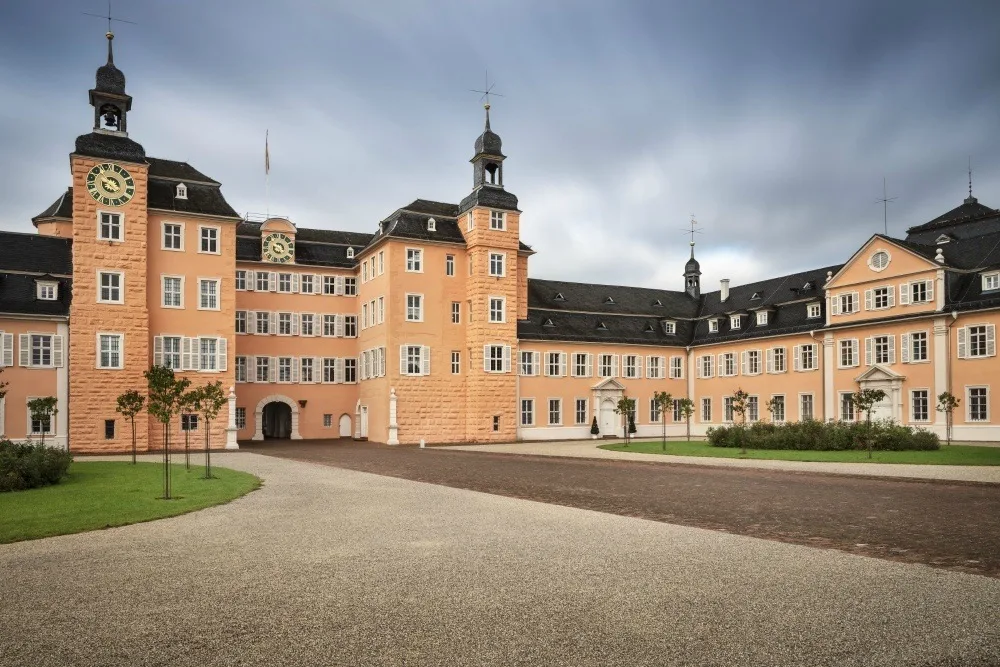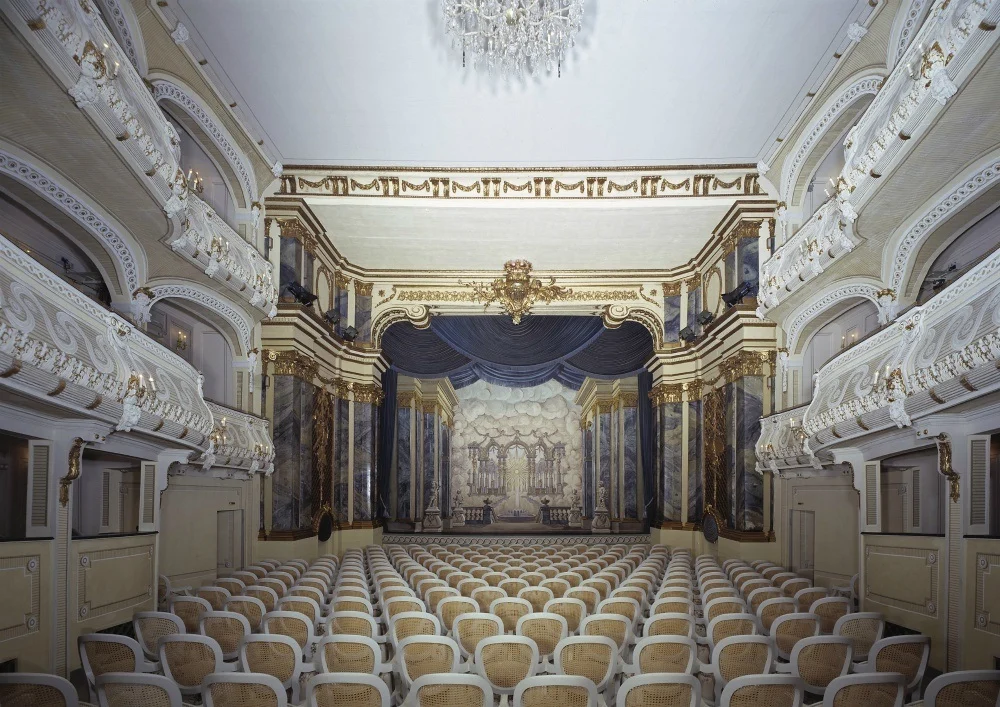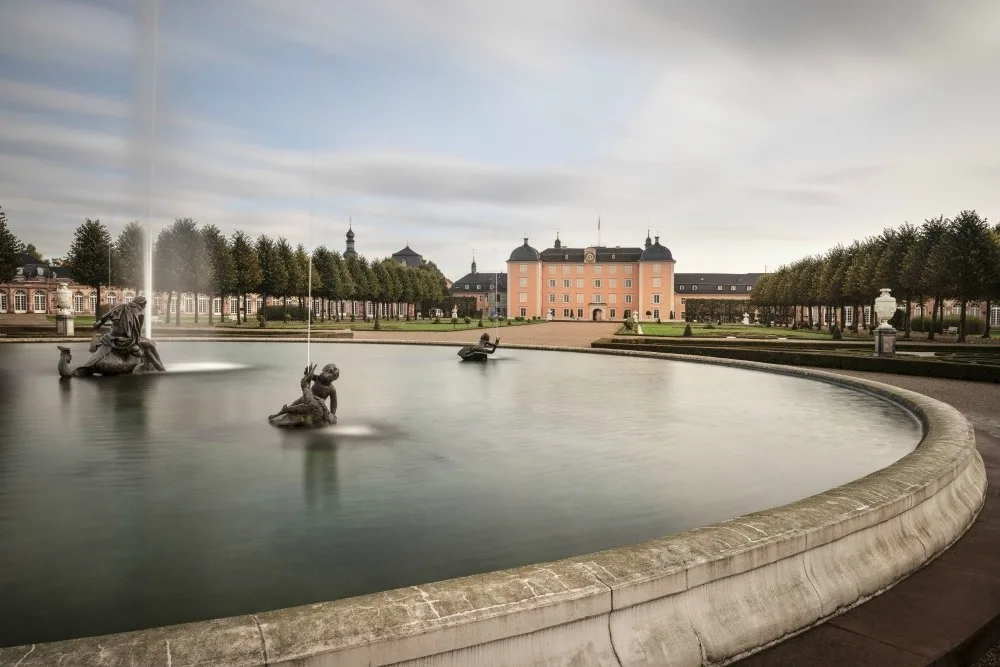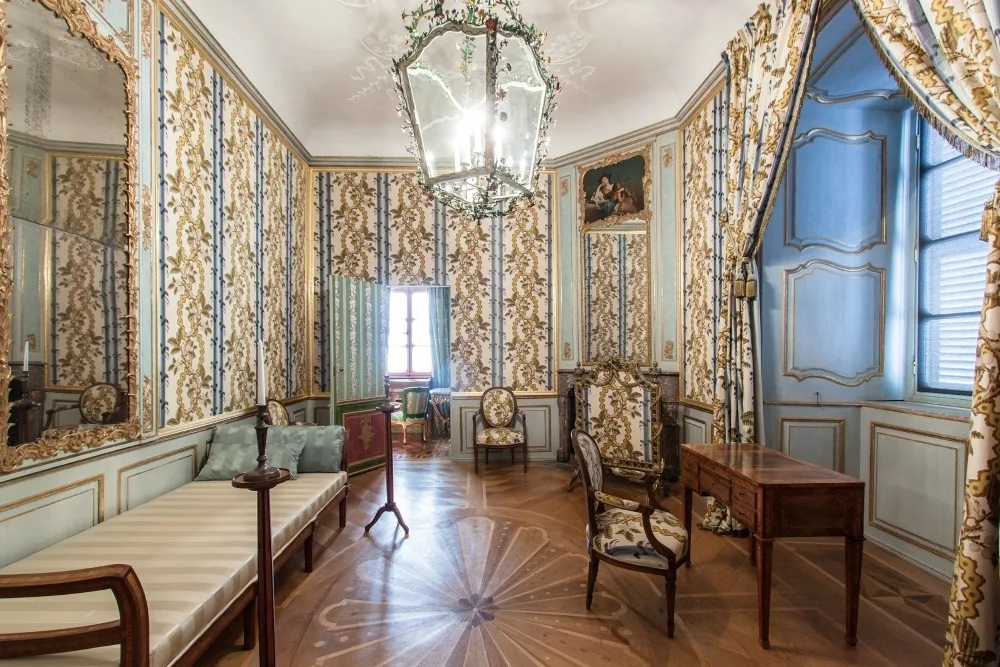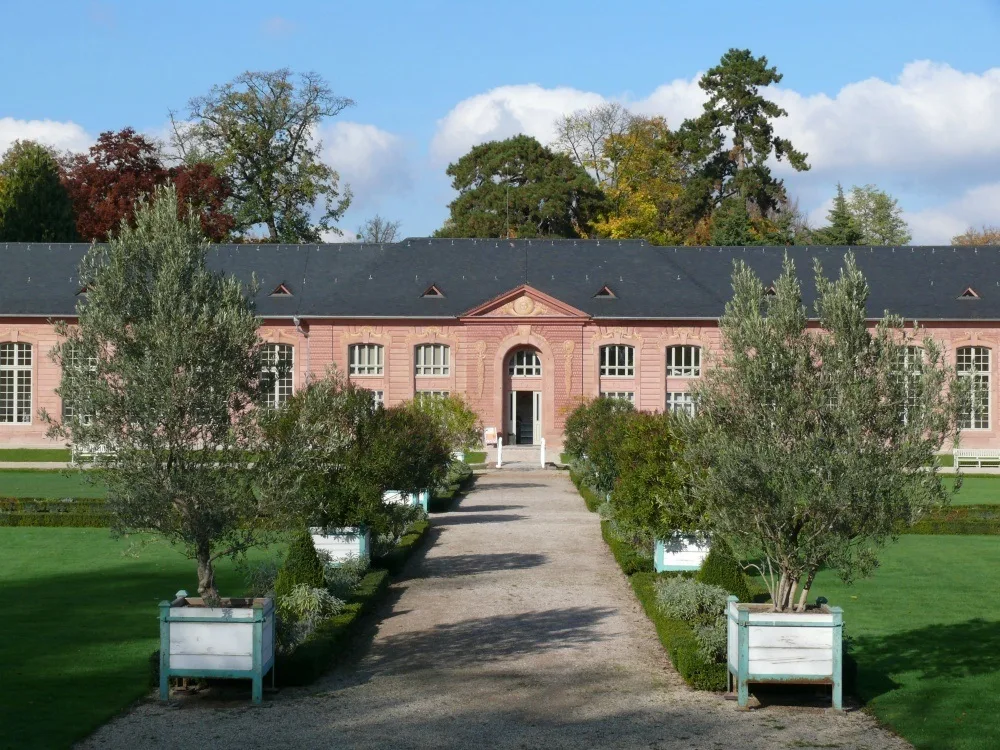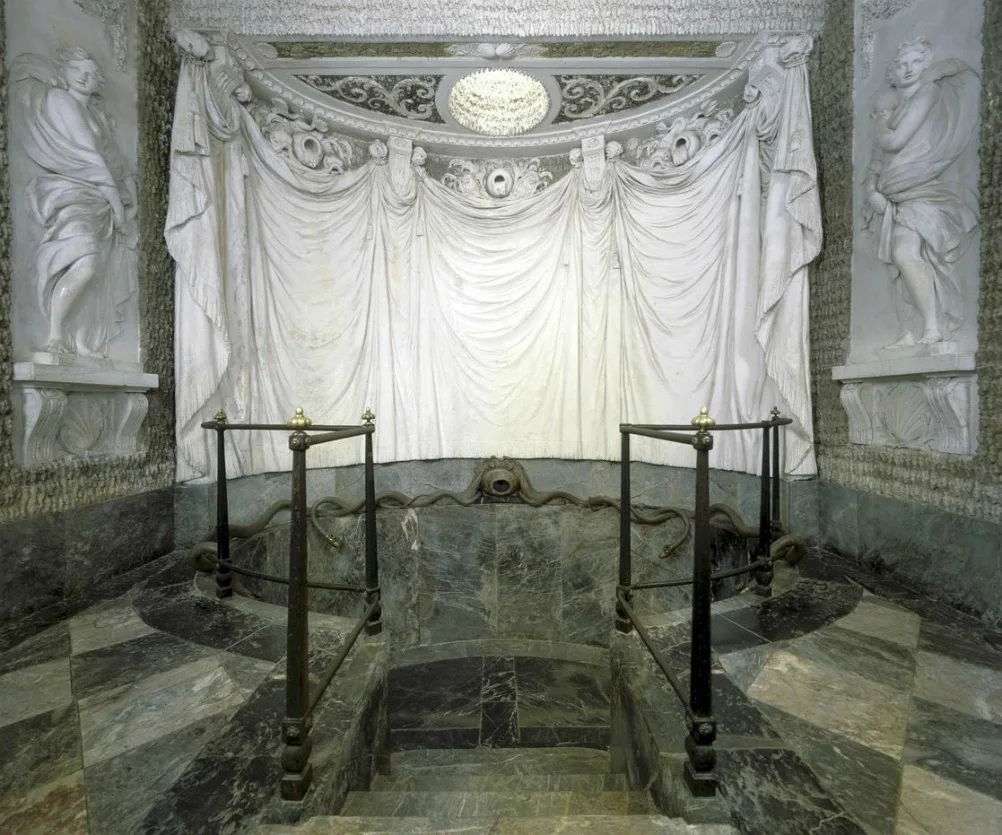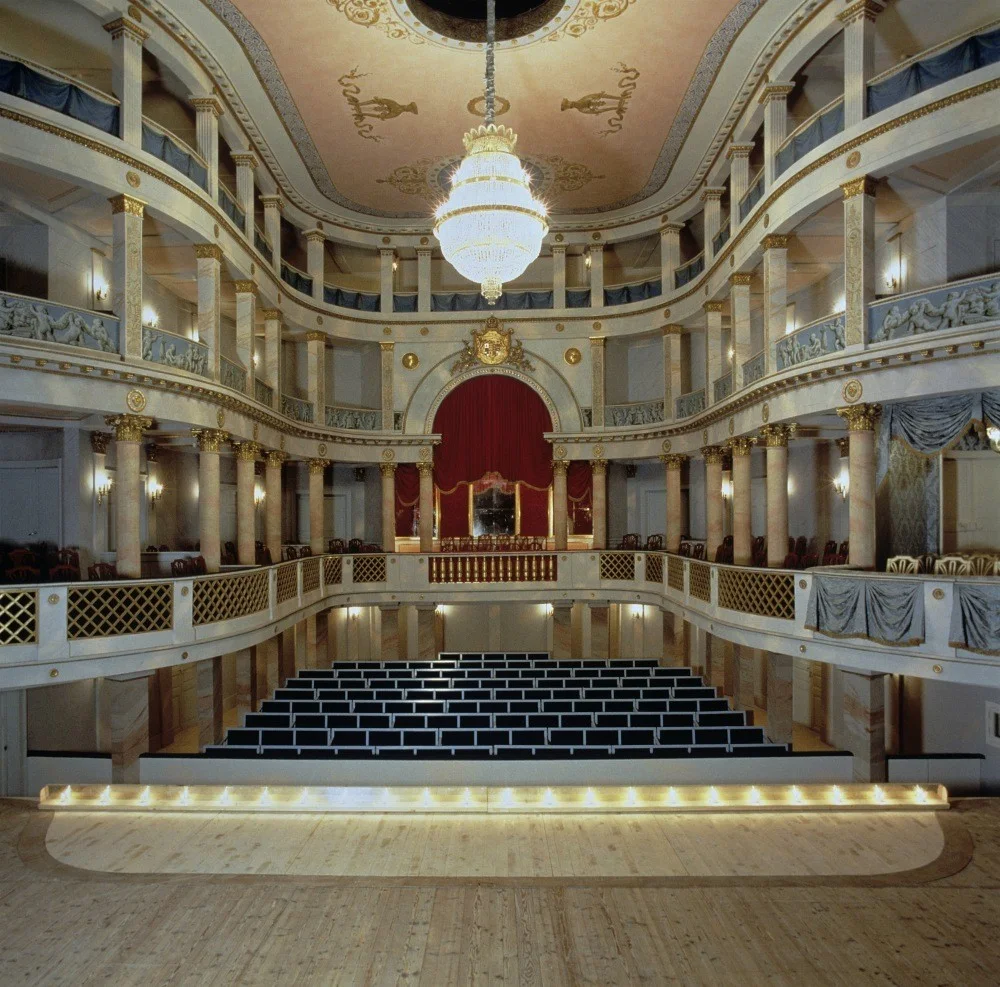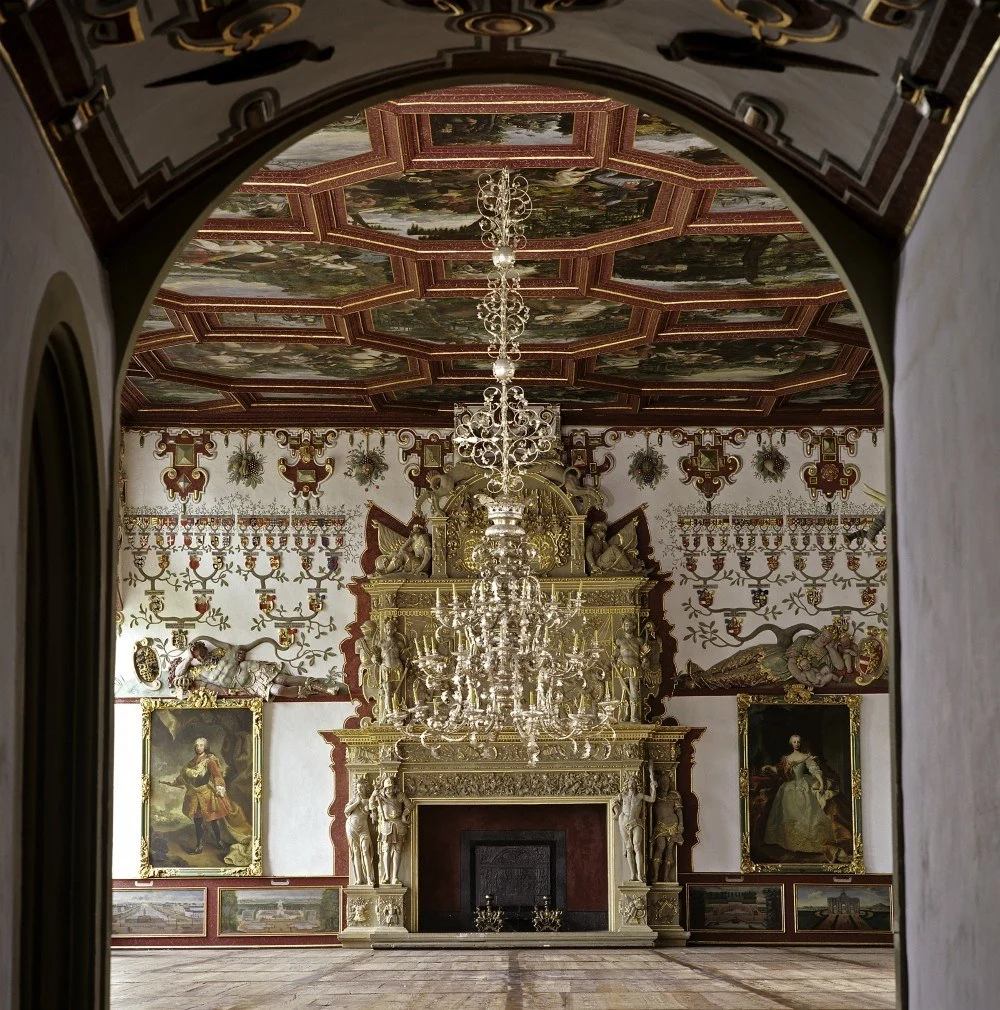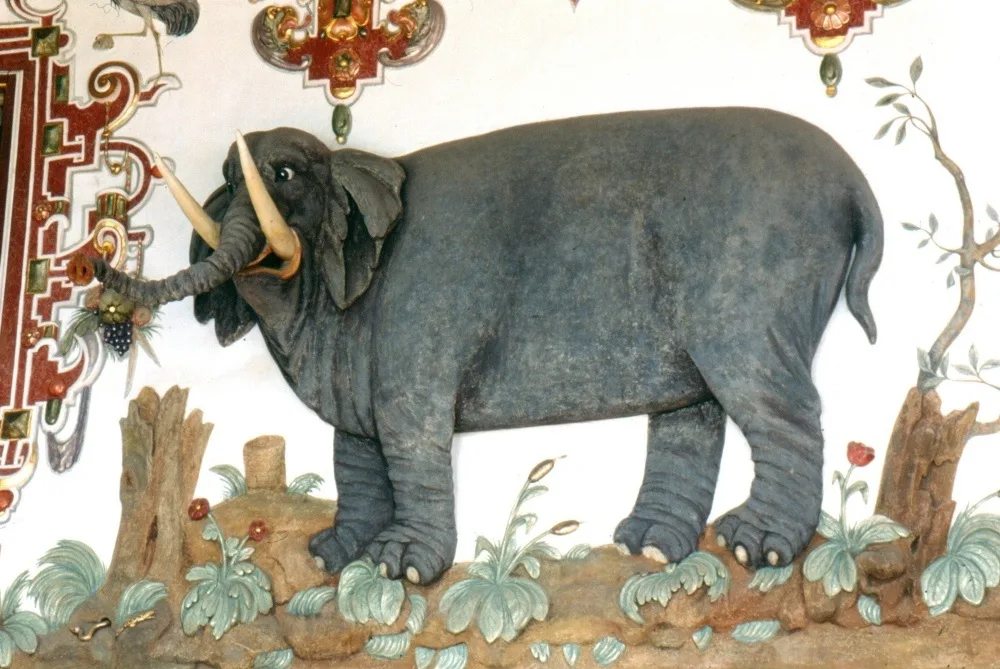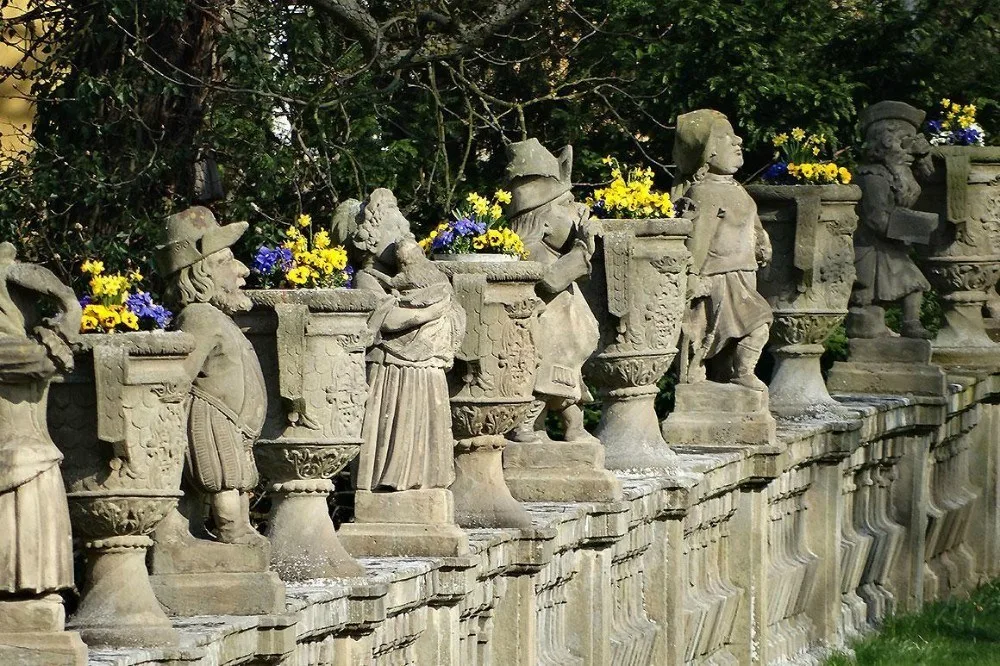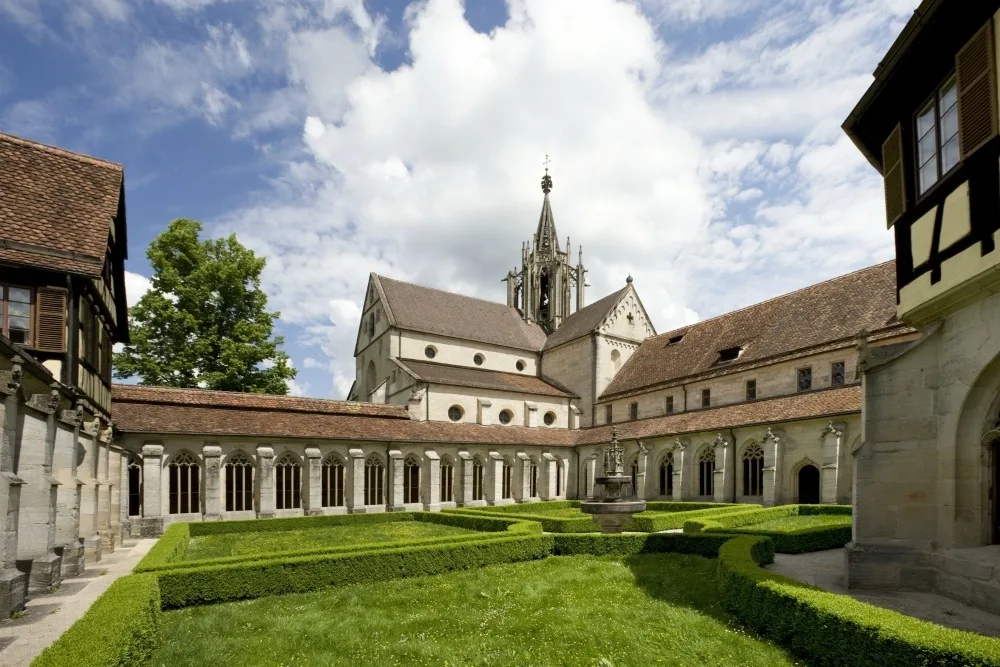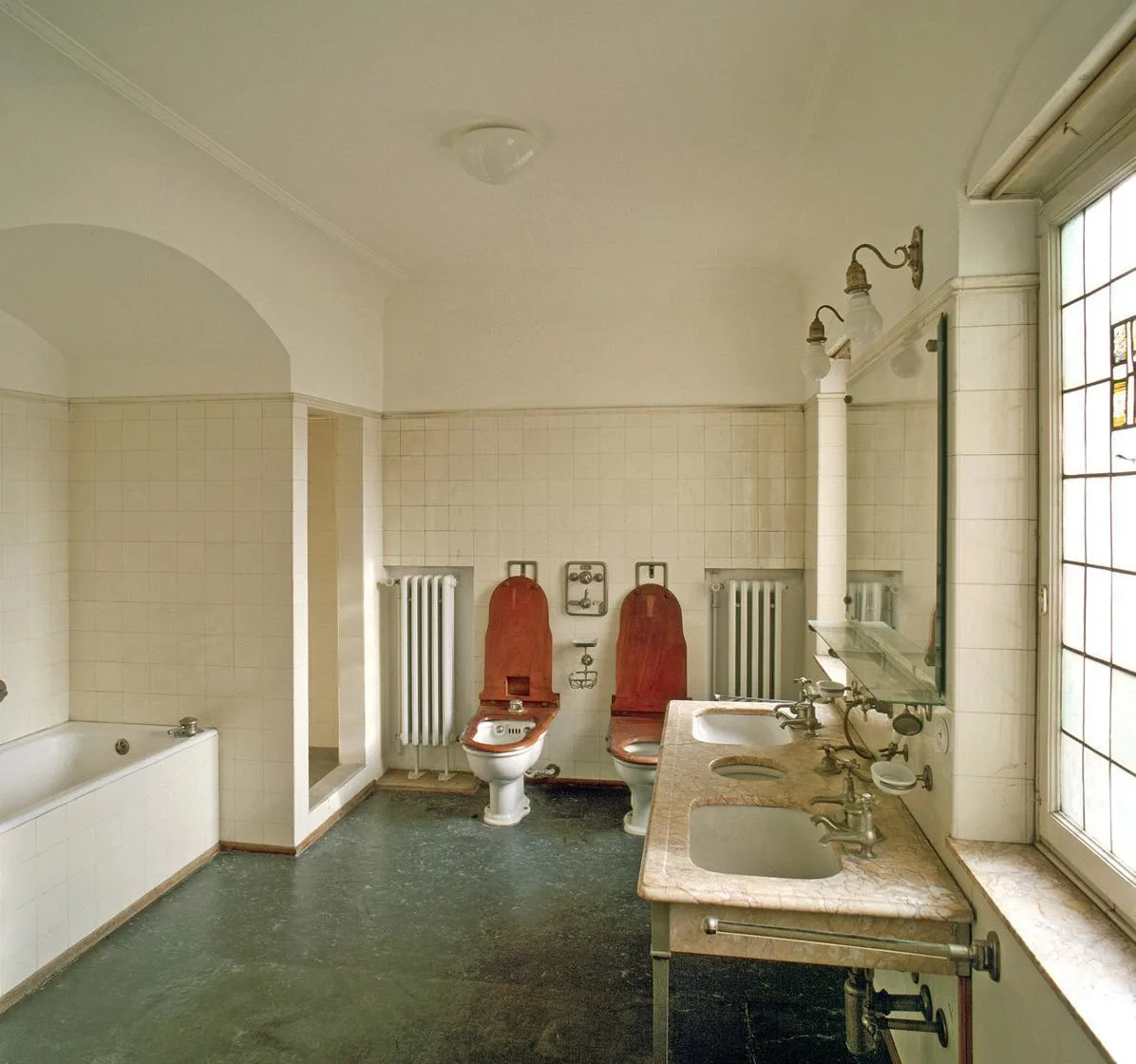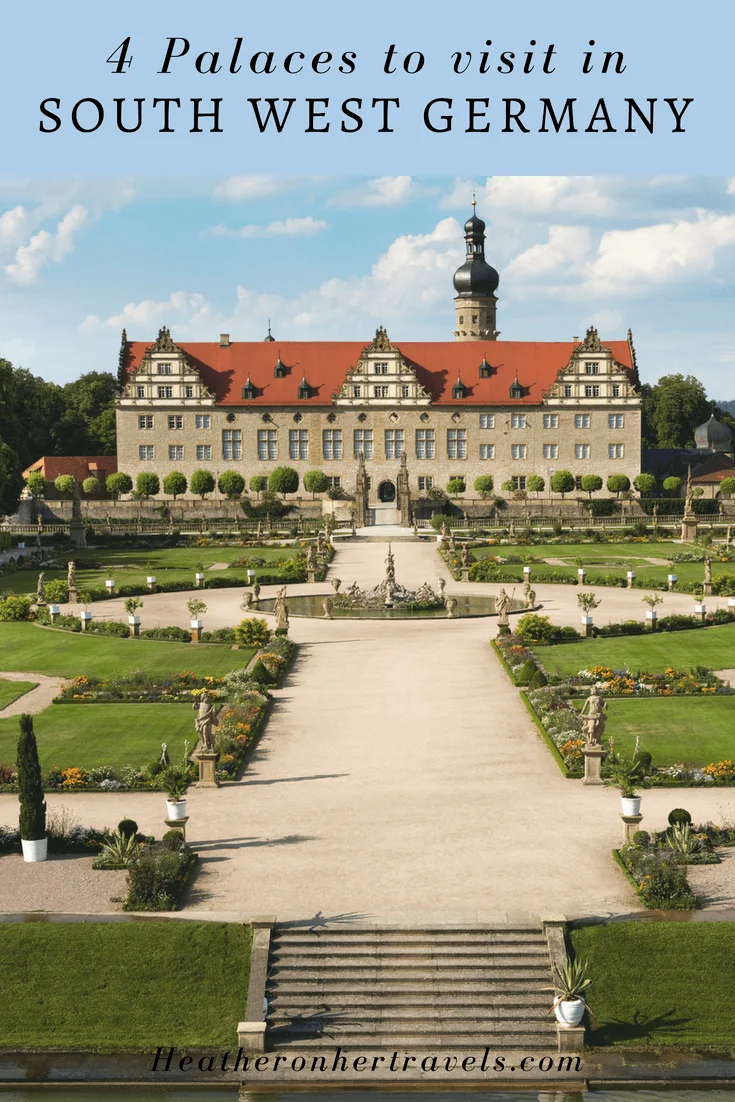If you are visiting the South West of Germany, there are plenty of palaces choose from, with decorative interiors and beautiful gardens. Here are just four that take you from opulent splendor to monastic austerity, from formal gardens to royal living on a domestic scale at Schwetzingen, Weikersheim, Ludwigsburg and Bebenhausen.
This region is famous for the castles and palaces built over the centuries to reflect the wealth and importance of the rulers of the Baden-Württemberg region. There are over 50 castles, palaces, monasteries and gardens. Some are UNESCO World Heritage sights, but all offer an insight into the splendour and wealth that funded them.
This article may contain affiliate links that provide commission on purchases you make at no extra cost to you. As an Amazon Associate I earn from qualifying purchases.
Visiting Schwetzingen Palace
Schloss Schwetzingen – A bit of history
Constructed as a small castle in the 14th century, the palace at Schwetzingen was greatly enlarged in the 17th century by the ruler of the Palatinate, Prince Elector Johann Wilhelm. Later Prince Elector Carl Theodor commissioned the formal gardens that you see today.
You may also enjoy: 12 fun things to do in Erfurt, Thuringia, Germany
The imposing palace building with wings on both sides is framed by the geometric parterres and fountains. Avenues of trees stretch in an orderly line into the distance.
Designed as a summer residence, Schwetzingen is also close to the castles in Southern Germany of Heidelberg and Mannheim. It would be easy to visit all three over a couple of days.
Schloss Schwetzingen – What is there to see?
You’ll want to wander through the extensive gardens at Schloss Schwetzingen. They include an English-style landscape garden and the Turkish gardens with an ornamental mosque. This mosque has never served any religious purpose.
There are sculptures scattered throughout the gardens. Small buildings like the temple of Apollo, enclose statues of the Greek Gods.
You may also enjoy: Seasonal things to do in Tübingen, SouthWest Germany – ChocolART chocolate festival and more!
Wander through the rooms of the palace admiring the fine 18th and early 19th century furniture and visit the Rococo Theatre in the north wing. This intimate palace theatre was designed for the entertainment of the Elector and his guests. They would have sat at the front with wooden benches for the rest of the audience behind them.
Gilded lattice work in the theatre concealed the musicians who played a fanfare as the ruler arrived. Stage machinery allowed amazing scenery changes. If you’d like to experience a performance in the theatre, the Schwetzingen Festival takes place every year between the end of April and mid-June.
Schloss Schwetzingen – Don’t miss!
The Bath House was created by Elector Carl Theodor as a private retreat from the constant gaze of the royal household. This pleasure lodge was designed for literature, music and conversation. It is decorated with beautiful classical frescoes.
In the Elector’s bathroom, a marble bath tub is set into the floor. Steps lead into the warm water which was piped through lead pipes from the nearby kitchen.
I can imagine that in the 18th century it must have seemed the height of luxury to bathe like a Greek God in such elegant surroundings!
You may also enjoy: A weekend in Coburg – video
Visitor information for Schloss Schwetzingen
Website | Open daily | Adults €11 | Palace may only be visited as part of a guided tour.
Getting there: The palace is 15 minutes drive from Heidelberg and 10 minutes’ walk from Schwetzingen train station. | More info
Need somewhere to stay? Check out these hotels in Heidelberg
Visiting Ludwigsburg Residential Palace
Ludwigsburg Residential Palace – A bit of history
Only 30 minutes drive from Stuttgart, the Ludwigsburg Residential Palace was built by the Dukes of Württemberg who left their mark all over this region. It is unique in showing the different architectural and decorative styles that were fashionable through the 18th centuries. You’ll see the progression from Baroque to Rococo to Neoclassical.
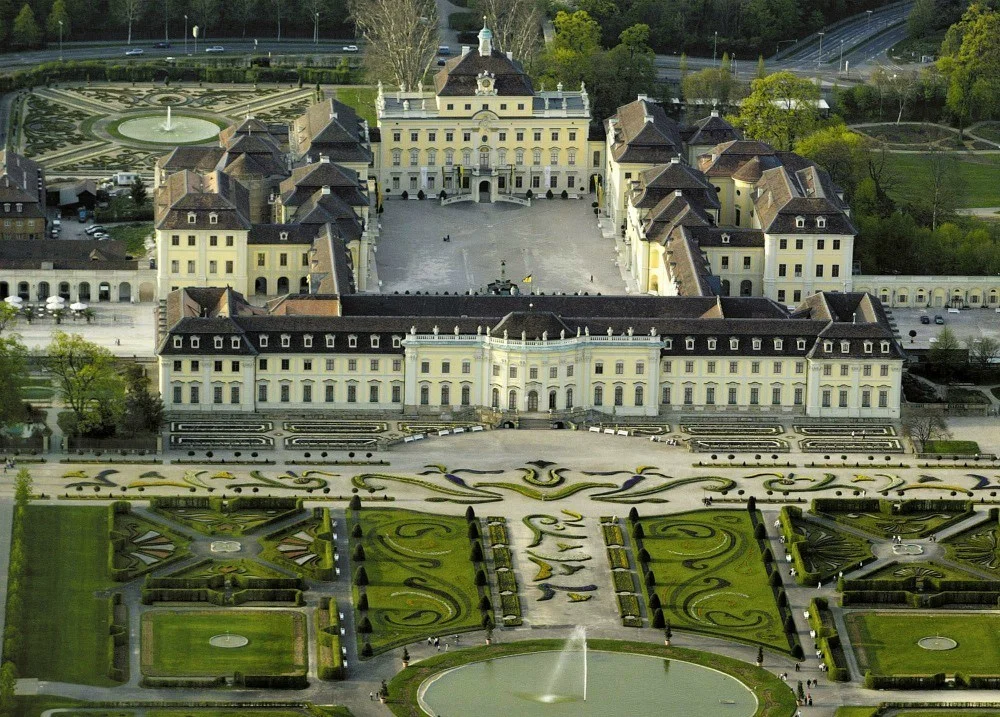
The palace was originally intended as a hunting lodge for Duke Eberhard Ludwig. It was enlarged in 1733 to include four wings around a central courtyard. The size and magnificence reflected its status as the Duke’s principal residence.
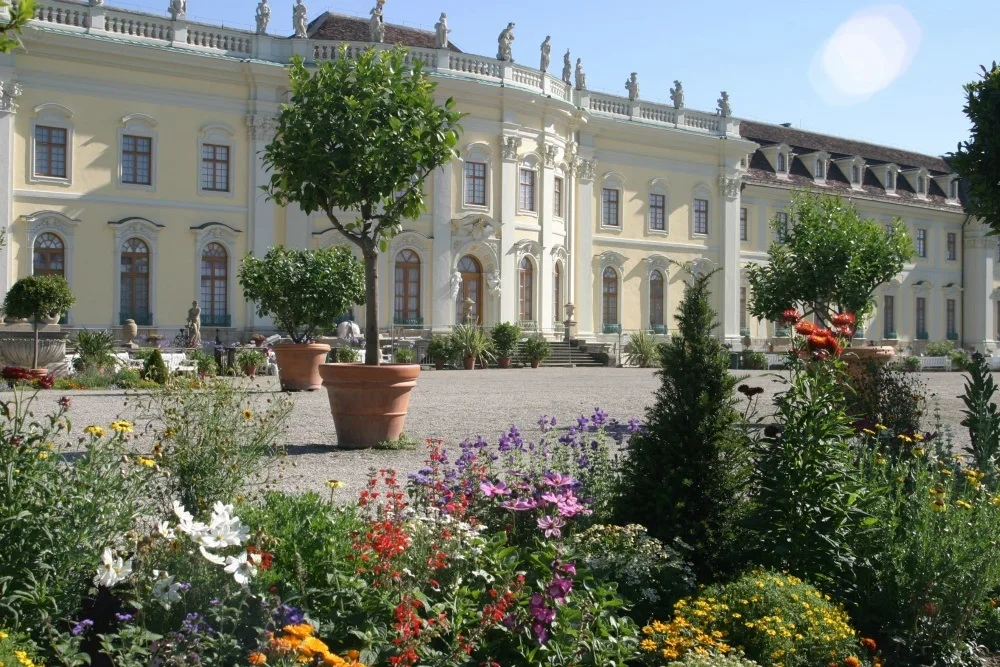
Ludwigsburg Residential Palace – What is there to see?
It would be easy to spend a day at the Ludwigsburg Residential Palace. It boasts a number of museums in addition to the apartments with their original decor, rare furniture and paintings.
Following their restoration in 2004, the private apartments of Duke Herzog Carl Eugen of Württemberg show the sumptuous Rococo style. View the gilding and stucco with playful hand painted motifs of flowers and birds.
You may also enjoy: A guide to Wartburg Castle and Eisenach – on the Martin Luther Trail in Germany
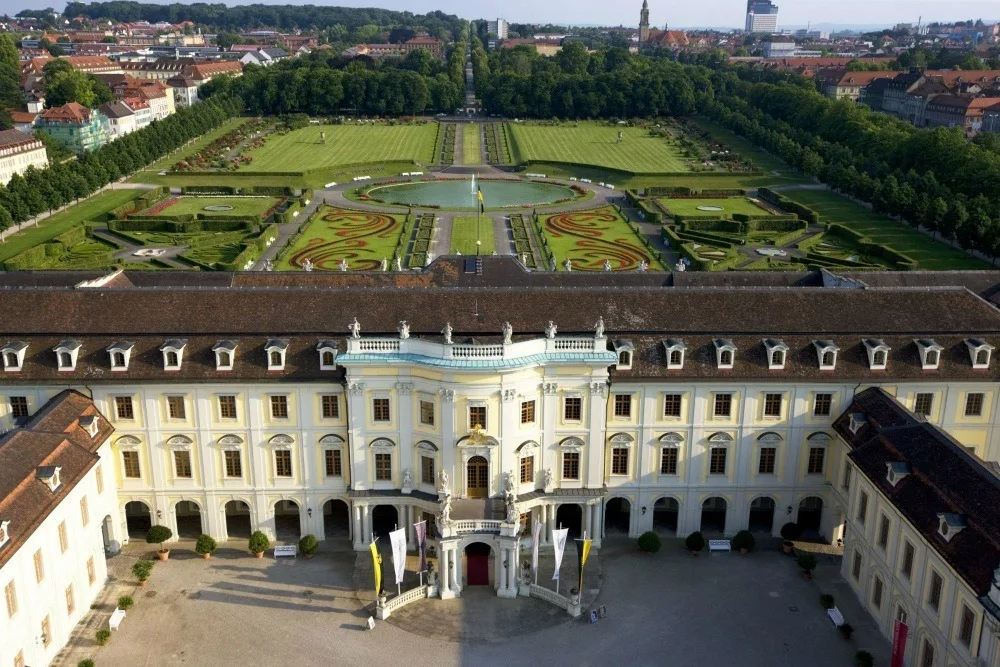
Visit the Ceramics Museum (Keramikmuseum), the Fashion Museum (Modemuseum) with clothing from the 18th to 20th centuries. The Baroque Gallery (Barockgalerie) houses historical artworks. In the East Wing is the Palace Theatre, one of Europe’s oldest theatres with the original decoration and stage machinery.
You may also enjoy: Heidelberg: Germany’s city of Romance
In the Theatre Museum you can find out about the ingenious machinery that allowed the stage sets to be changed with lightening speed. Spectacles and illusions could be created imitating the sound of wind, rain and thunder.
The Marmorsaal or Marble Hall was commissioned by King Frederick I in 1815 to remodel the Baroque style ballroom in line with the fashionable taste of the time for classicism.
On the vaulted ceiling, the fresco depicts a blue sky with huge chandeliers. These look as if they are being carried by wild birds. The upper tiers of the room are decorated in garlands and goddesses in plaster stucco interspersed with opulent yet elegant gold decoration.
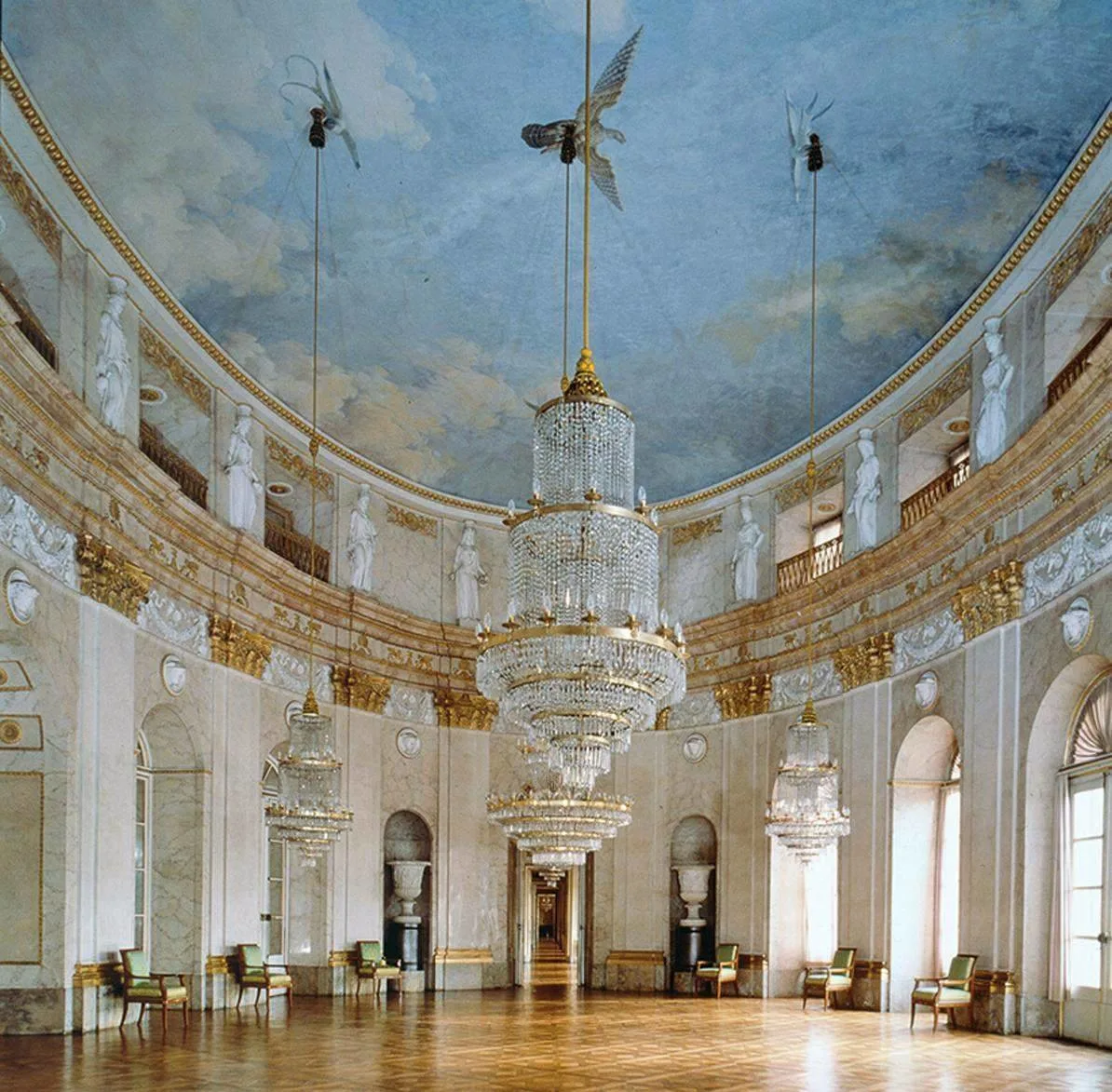
Ludwigsburg Residential Palace – Don’t miss!
The Kinderreich is an interactive museum where children are allowed to experience the sights, sounds and life at court of 300 years ago. Visitors are positively encouraged to touch the exhibits and dress up in the costumes of the time, to learn more about life in the past at Ludwigsburg Residential Palace.
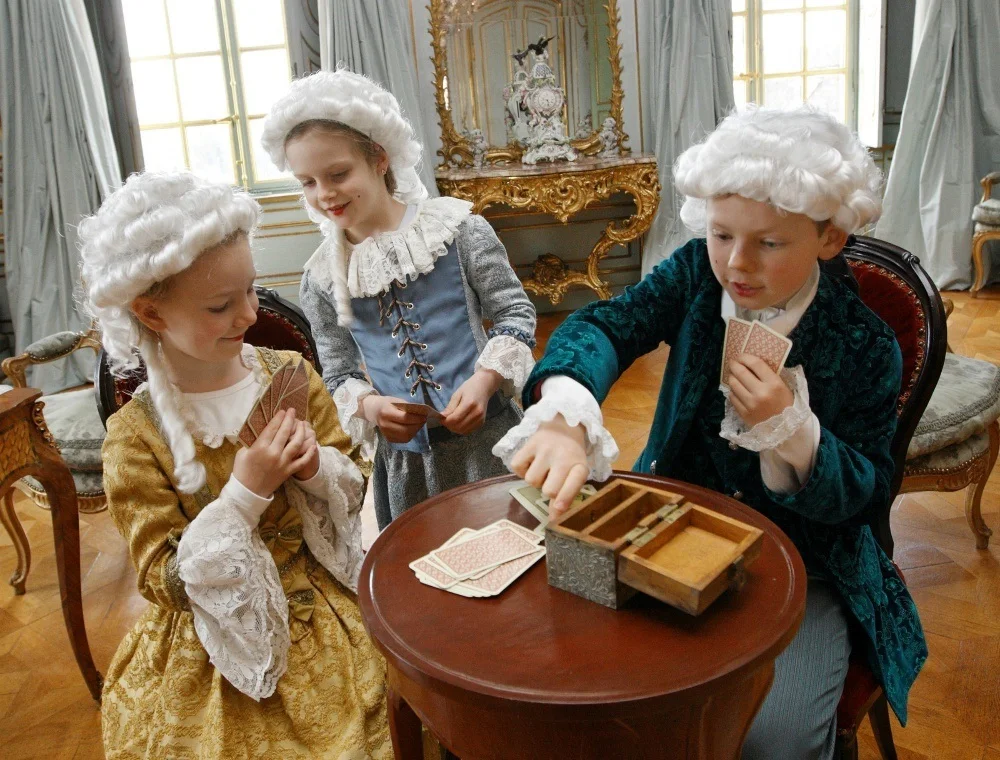
Visitor information for Ludwigsburg Residential Palace
Website | Open daily | Residential Palace Adults €9 Museums €3 | Palace may only be visited as part of a guided tour.
Getting there: The palace is 30 mins drive from Stuttgart, and can be reached by bus from Ludwigsburg bus station | More info
Need somewhere to stay? Check out these hotels in Ludwigsburg
Visiting Schloss Weikersheim
Schloss Weikersheim – A bit of history
Set in the scenic Tauber Valley, Schloss Weikersheim sits at the heart of the small town of Weikersheim. In the 16th century, Count Wolfgang of Hohenlohe ordered the construction of a new palace here on the site of his former moated castle. It’s built in the Renaissance style as the ideal country estate for a modern ruler.
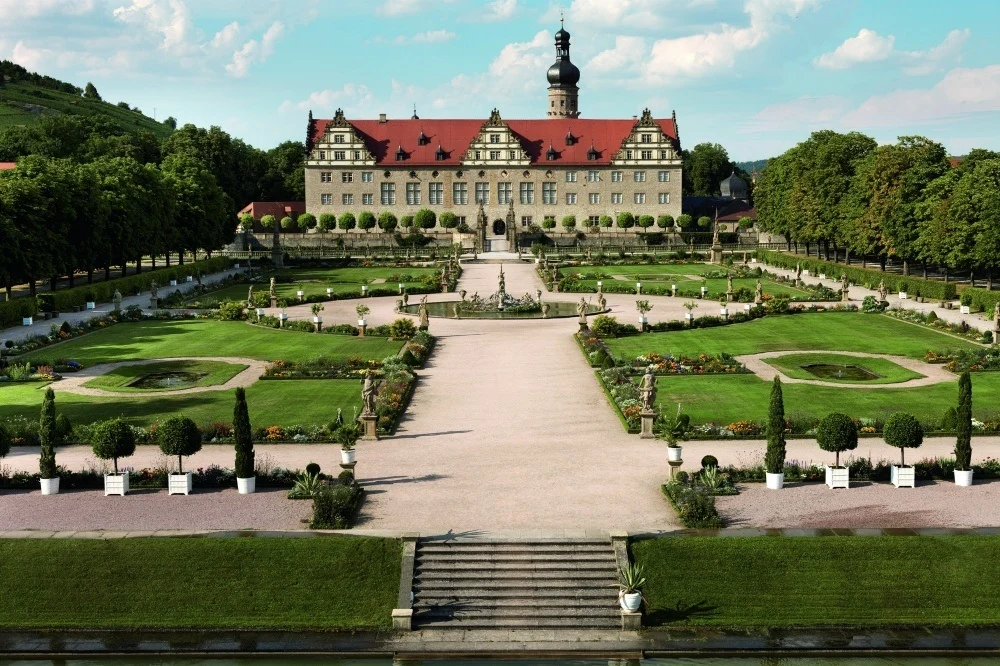
A century later, Count Carl Ludwig of Hohenlohe developed the palace and created the garden in its current form, with statues and an orangery.
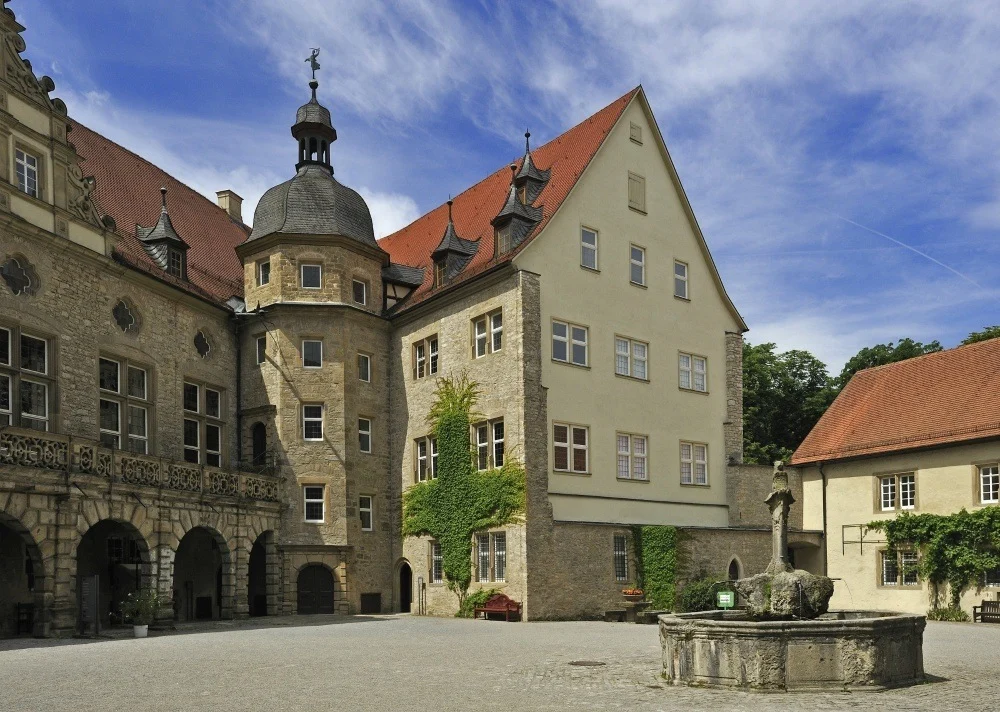
Schloss Weikersheim – What is there to see?
The richly decorated Knight’s Hall dates back to 1600. It is famous for the vast paneled ceiling covered with hunting scenes.
The painted stucco decoration depicts all kinds of wildlife, both those that would have been familiar and those that were more exotic. For example, the elephant would certainly not have been found in the forest nearby!
You may also enjoy: My Rhine River Cruise: A weekend of history, wine and music
Hunting was only permitted as an entertainment for the nobility. Perhaps this elephant is a symbol of the exotic and mysterious that only rulers could afford.
The Knights’ Hall includes a large and ornate fireplace with its unusual reliefs and figures. The Count’s family tree is above, justifying is claim to rule and high position through rightful inheritance.
One of the most elaborate rooms of the palace is the Mirror Cabinet completed in 1718 for Princess Elisabeth Friederike Sophie. This small room with walls covered with red silk damask was created as a walk-in display cabinet.
It houses the princess’s collection of East-Asian porcelain, glazed earthenware from Ansbach, miniatures and elaborate figures in silver and precious stones. The vases and figurines were displayed on wall consoles and tables, surrounded by mirrors and gilded carvings.
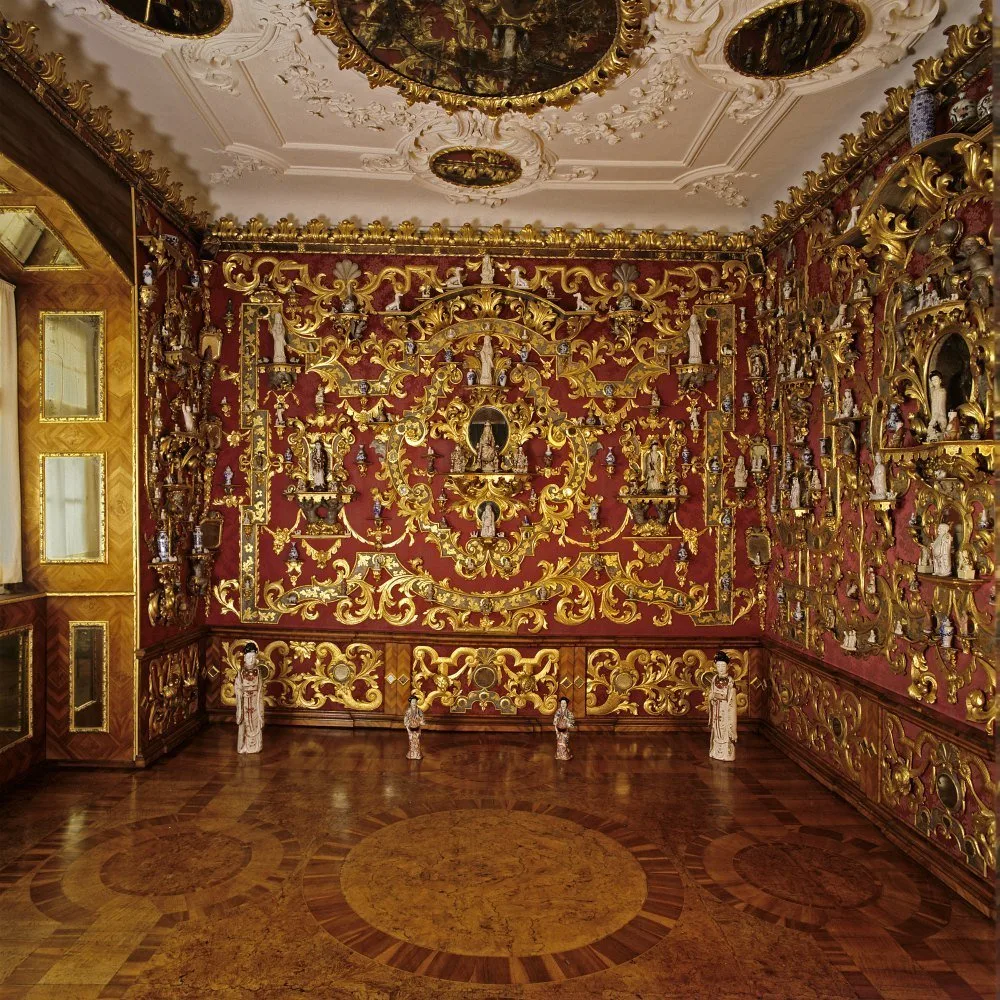
Schloss Weikersheim – don’t miss!
In the palace gardens look out for the balustrade with comical figures of dwarfs, which are thought to be caricatures of the royal household. They were created in 1712 by sculptor Johann Jakob Sommer of Künzelsau. Sommer came from a well known family of artists who worked on the royal estate.
It was common in the 18th century for there to be a court dwarf or jester who were considered figures of fun and curiosity, although these figures are thought to be imaginary characters rather than based on real people.
Visitor information for Schloss Weikersheim
Website | Open daily | Adults €10 | Palace may only be visited as part of a guided tour, gardens can be visited without a tour
Getting there: The palace is 1hr 40 mins drive from Stuttgart, 2 hrs drive from Frankfurt and can be reached by public transport: from Bad Mergentheim to Weikersheim by train or by the bus that runs between Crailsheim and Bad Mergentheim | More info
Need somewhere to stay? Check out these hotels in Weikersheim
Visiting Bebenhausen Monastery and Palace
Bebenhausen Monastery and Palace – a bit of history
Set among the rolling hills of the Schönbuch nature reserve, Bebenhausen Monastery is one of the best-preserved Cistercian abbeys in Southern Germany. The monastery was founded in the 12th century by Rudolf, Count Palatine of Tübingen, and developed into one of the wealthiest monasteries in the region.
After the Reformation, the number of monks dwindled and the monastery was finally dissolved in 1648. The densely forested area around the monastery was a favourite hunting spot of the Kings of Württemberg and from 1868, parts of the monastery complex were converted into a royal hunting palace.
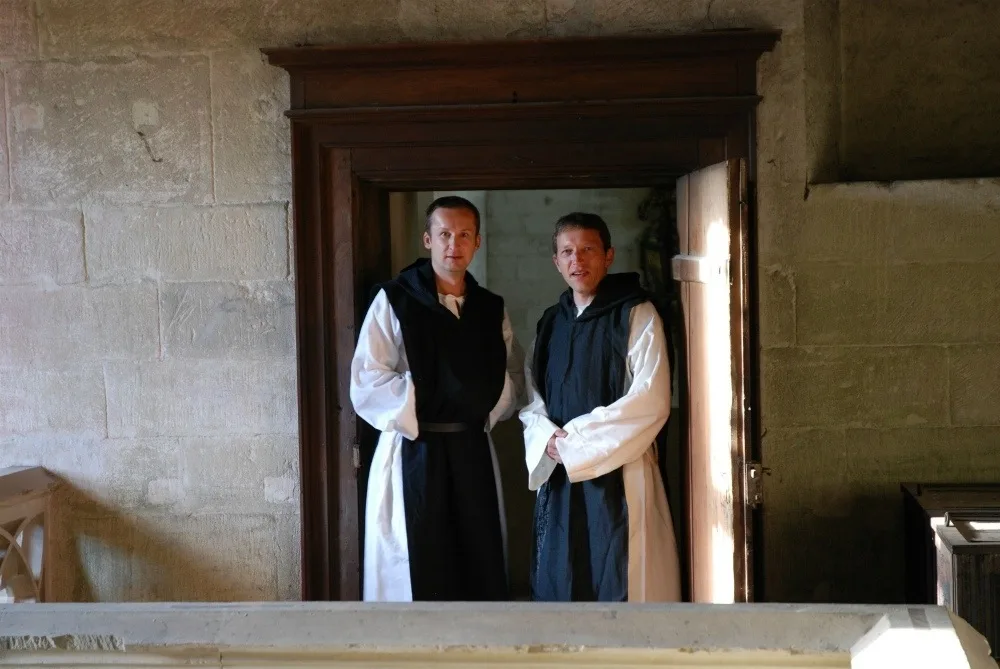
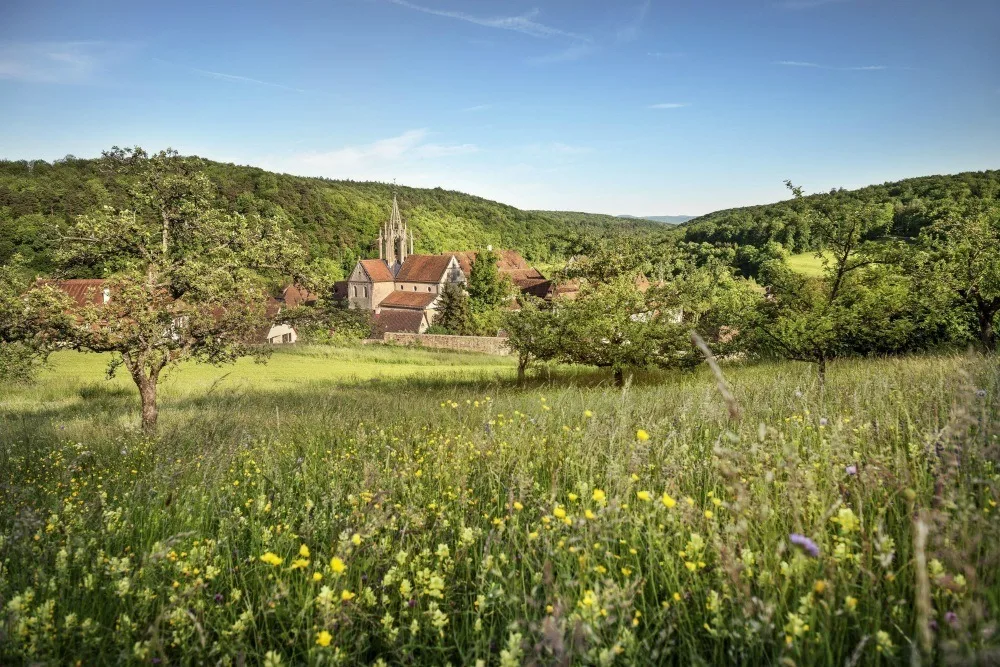
Bebenhausen Monastery and Palace – What is there to see?
A guided tour will illuminate the lives of the monks and schoolboys who lived in this Medieval Cistercian Monastery and you can visit the buildings of the church, main monastery building, abbot’s residence, guesthouse and infirmary.
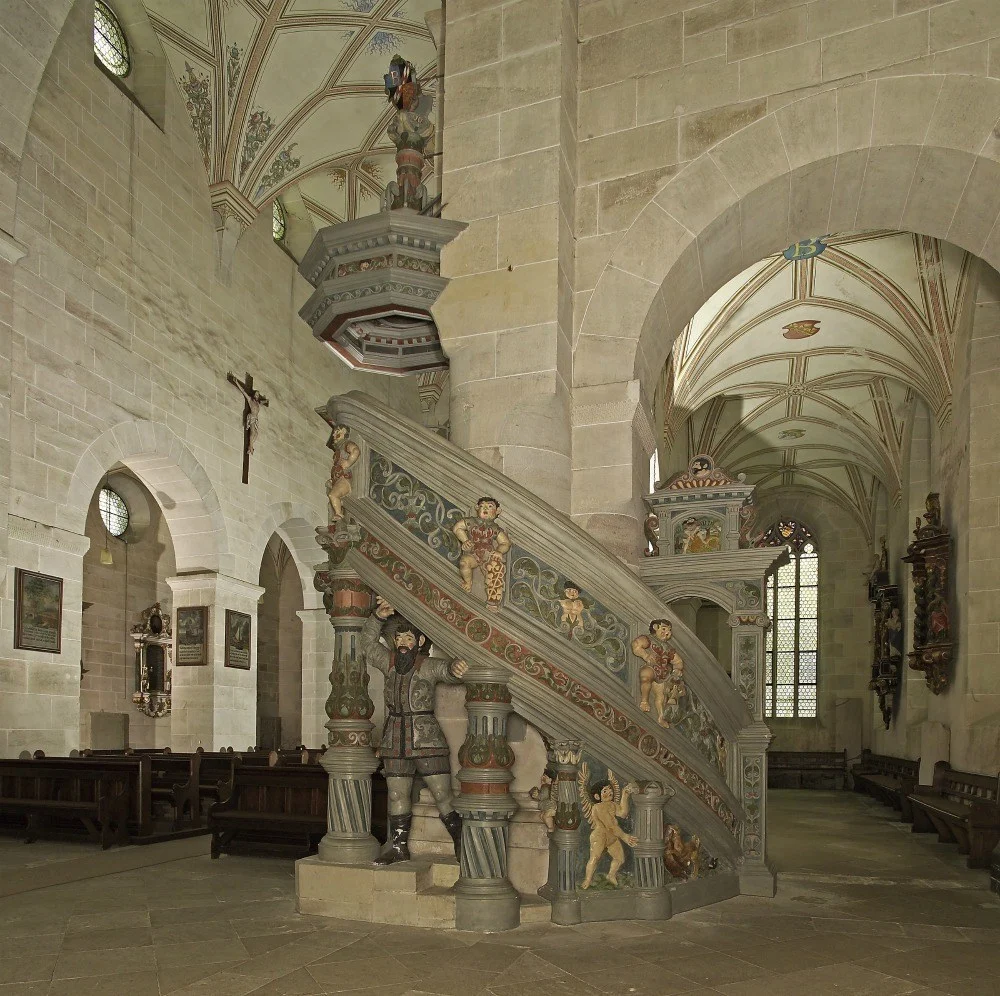
The famous Summer Refectory, is a light and airy dining hall with fan-vaulted ceiling in late Gothic style with delicate decoration. A winter refectory was created in the 16th century with underfloor heating and this was taken over by King Karl I for use as his dining hall.
You may also enjoy: 3 days in Munich – our itinerary of things to see and do
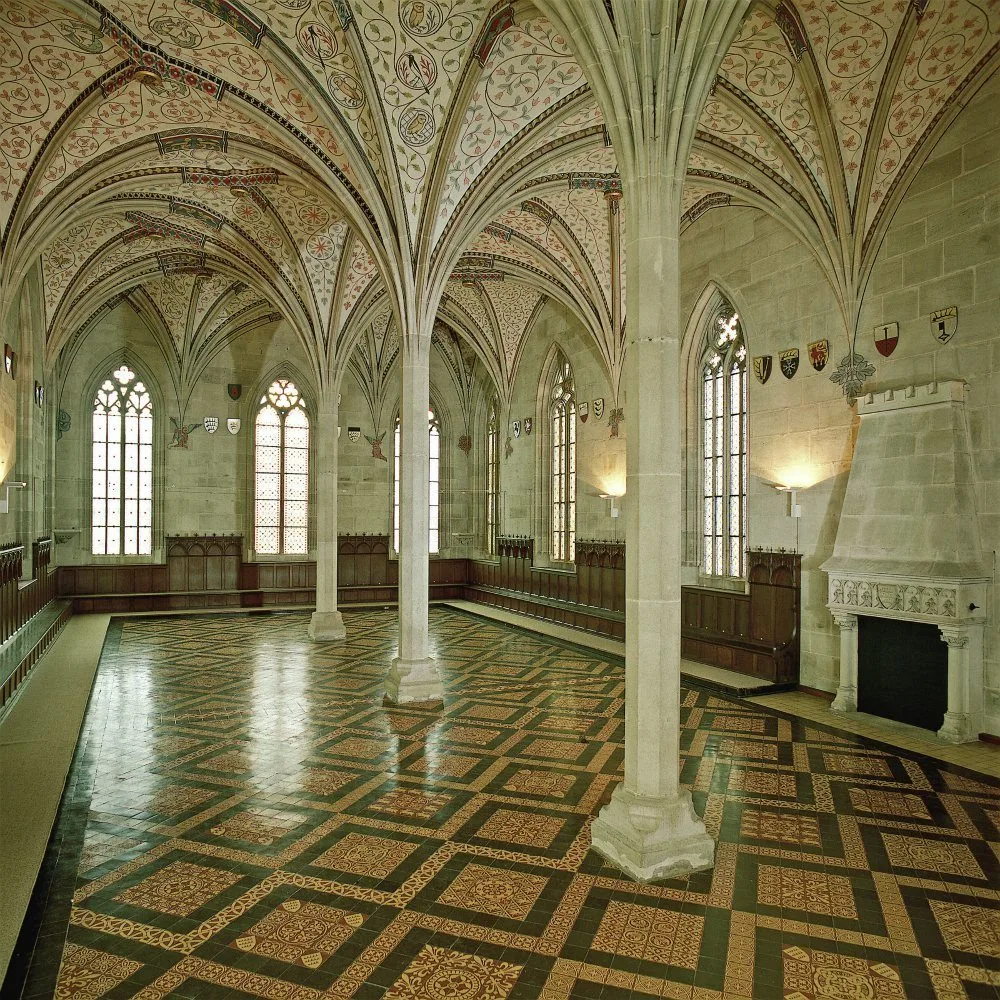
Some of the monastery buildings were taken over by King Karl I when he established his palace in 1873, and he added suits of armour and weapons to create a medieval theme that was popular at the time.
After Württemberg ceased to be a monarchy in 1918, the royal couple, Wilhelm II and Charlotte, were given the right to remain in Bebenhausen for the rest of their lives. The Grüne Saal (green room) was decorated in Art Nouveau style and & the kitchen was installed in 1915, representing the height of modernity at the time.
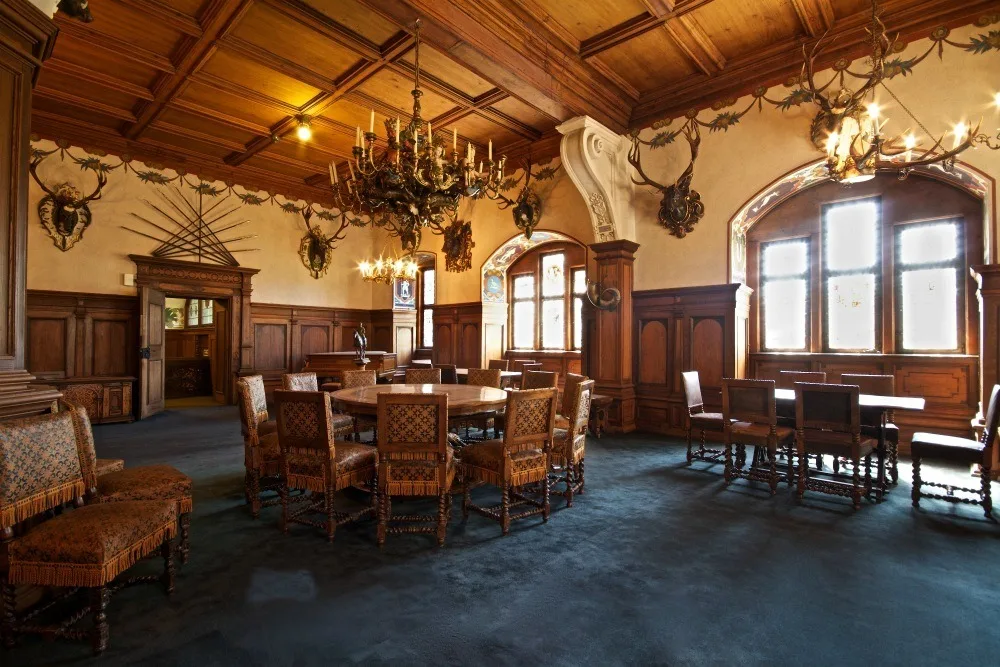
Bebenhausen Monastery and Palace – Don’t miss!
Wilhelm II and Queen Charlotte updated their apartments in the Bebenhausen Palace and you can see the queen’s bathroom which although a hundred years old, still seems stylish and modern. With both bath and shower, a toilet and bidet and a marble wash stand with two basins, offering running hot and cold water and central heating, this bathroom was luxurious by the standards of the time and was in use by the Queen until her death in 1946.
Visitor information for Bebenhausen Monastery and Palace
Website | Open daily, Palace must be visited by guided tour available every hour | Combined ticket for Palace and Monastery Adults €10
Getting there: The monastery and palace is around 40 minutes drive from Stuttgart and can also be reached by bus from Stuttgart or Sindelfingen | More info
Need somewhere to stay? Check out these hotels in Stuttgart
Visitor information for visiting South West Germany
For more information about the Palaces, Castles and Gardens of South West Germany and the Baden-Württemberg region, please visit the Palaces and Gardens website.
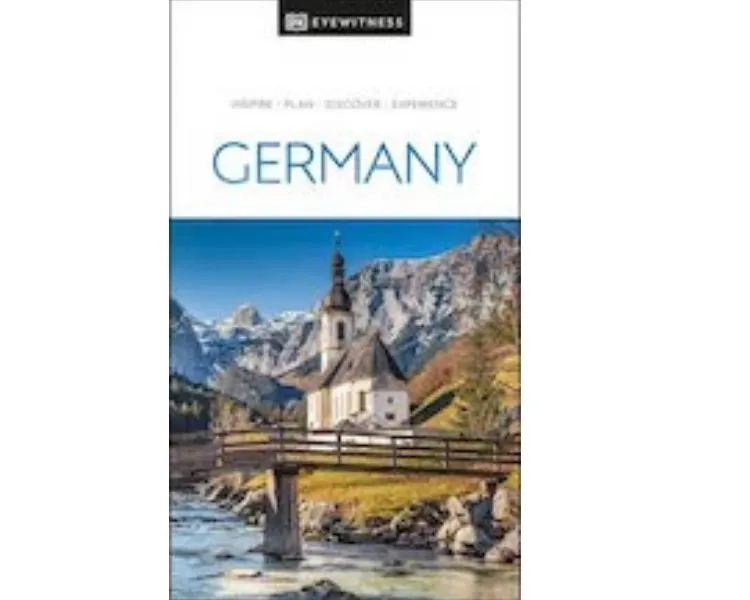
Need a guide book for Germany? We recommend the DK Eyewitness Germany Travel Guide
For more information on planning your holiday in South West Germany, please visit the Sunny Side of Germany Baden-Württemberg region website.
Need a guidebook for your travels in Germany? We recommend the DK Eyewitness Germany Travel Guide
Pin It
This article was sponsored* by the Baden-Württemberg tourism board of Germany
* More info on my policies page
This article is originally published at Heatheronhertravels.com


